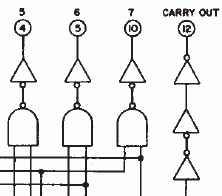danny davis
Banned

On schematics at my job, they use circles on the inputs of gates , what are the names for these types of negative logic gates?
They aren't called AND, OR, NAND, NOR, Exclusive OR or NOR, they have different names , what are they called?
When would a circuit or in general want to use Negative Logic gates?
The Negative logic gates have internal inverter buffers on the input that are internally inside the IC Chip
Basic Negative Logic tricks:
1.) You can use input inverter buffers before an OR gate to make to make a NAND gate
2.) You can use input inverter buffers before an NAND gate to make an OR gate
3.) You can use input inverter buffers before a AND gate to make a NOR gate
4.) You can use input inverter buffers before a NOR gate to make a AND gate
5.) can you add to the list?
- - - Updated - - -
I think they call them
INVERTED AND gate
Inverted OR gate
Inverted NAND gate
Inverted NOR gate
- - - Updated - - -
I sometimes see them called Negative
I think they call them
Negative AND gate
Negative OR gate
Negative NAND gate
Negative NOR gate
They aren't called AND, OR, NAND, NOR, Exclusive OR or NOR, they have different names , what are they called?
When would a circuit or in general want to use Negative Logic gates?
The Negative logic gates have internal inverter buffers on the input that are internally inside the IC Chip
Basic Negative Logic tricks:
1.) You can use input inverter buffers before an OR gate to make to make a NAND gate
2.) You can use input inverter buffers before an NAND gate to make an OR gate
3.) You can use input inverter buffers before a AND gate to make a NOR gate
4.) You can use input inverter buffers before a NOR gate to make a AND gate
5.) can you add to the list?
- - - Updated - - -
They aren't called AND, OR, NAND, NOR, Exclusive OR or NOR, they have different names , what are they called?
I think they call them
INVERTED AND gate
Inverted OR gate
Inverted NAND gate
Inverted NOR gate
- - - Updated - - -
I sometimes see them called Negative
They aren't called AND, OR, NAND, NOR, Exclusive OR or NOR, they have different names , what are they called?
I think they call them
Negative AND gate
Negative OR gate
Negative NAND gate
Negative NOR gate




